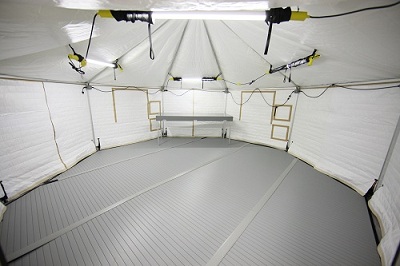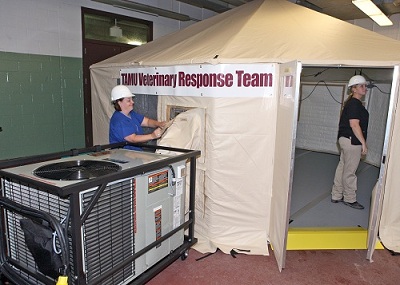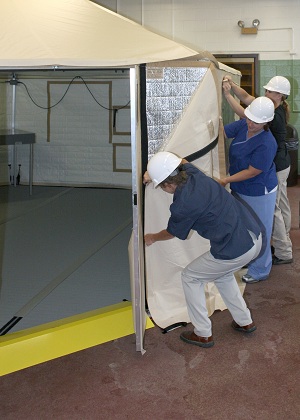Texas A&M College of Veterinary Medicine and Biomedical Sciences Ready to Respond
The first hurricane of the 2010 hurricane season, Hurricane Alex, put many Texas agencies on alert. Texas Task Force-1 was activated and deployed to respond to anticipated flooding condition in South Texas. Ready and waiting should they be needed was the Veterinary Emergency Team (VET) from the Texas A&M College of Veterinary Medicine & Biomedical Sciences.

Knowing that Brazos County was going to be a designated evacuation hub for hurricane threats and eager to find a solution where experts in animal welfare could respond in the event of a disaster, talks were initiated shortly after Hurricane Rita between the college and the Emergency Response staff of Brazos County.
To respond in an emergency, the team has acquired special equipment and the funds to not only purchase this equipment, but also to support the team. Funds were requested and received from the Texas Division of Emergency Management and other sources, and have immediately been used to build the necessary infrastructure for the emergency response teams.

“Once we knew that we were going to be able to develop formalized teams, we began to organize under the name TAMU VET, or Texas A&M University Veterinary Emergency Team,” said Bissett. “We have purchased some special tents, satellite equipment, portable stocks & stalls, kenneling materials, etc. so that when we are out in the field, we are able to deploy as a fully self-sustaining unit.”
While deployed, the team is able to do assessments of animals and triage the injured. This process can include doing toxicity sampling of water supplies to better know what is available to stranded livestock and pets, evaluating food and nutrition needs, and developing ways to stabilize the injured animals and get them to safety and shelter.
“We want to limit animal suffering,” said Bissett. “So animal welfare will be paramount to our thinking. Our college was founded on service to the state, so being able to respond when animals in the state are in need is in our tradition of service.”

Not only have these teams dedicated themselves to being available to provide needed aid during a disaster, but they also are using these opportunities as a teaching tool for future veterinarians. Three veterinary medical students serve on the TAMU VETs at any given time.
As Alex ran ashore on the Mexican coast, the TAMU VET team organized gear and personnel to make sure that should the call come to mobilize, they would be ready. Alex was only the first hurricane of the season and won’t be the last. With TAMU VETs loaded and ready, animals caught in a disaster situation will have a dedicated response unit headed their way.
“There are many roles to fill in a time of disaster,” added Bissett. “Our students are able to see how emergency response is something that brings in faculty from the clinics in a multi-disciplinary effort. Not everyone is deployed. As a major referral hospital, the CVM also needs faculty to remain in the hospital to take care of emergent animal needs that arrive from shelters, from evacuees passing through, and from the deployed teams. There’s a role for everyone, and it takes everyone to be successful at what we do.”


